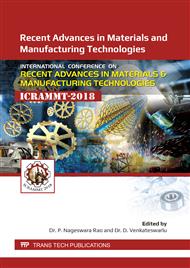p.637
p.644
p.650
p.656
p.662
p.669
p.678
p.685
p.691
Effect of Milling Time on Consolidation of Al5083 Nanocomposite by Equal Channel Angular Pressing
Abstract:
The effect of milling time on consolidation of Al5083-5wt. % nanoyttrium oxide powders which are milled from 0-35 hours using planetary ball mill. nanocrystalline structure was observed after 10hours of milling. X-ray diffraction results reveals the formation of 57nm and 31nm for 20hr and 35hr of milling with increase in lattice strain. Circular and Elliptical morphology of milled powders were confirmed through SEM with decrease in particle size. The 90o die channel angle ECAP die was used to consolidate 20hr and 35hr milled powder aided with and without back pressure. The optical micrographs reveal the formation of fine grains. The35hr milled powder shows the maximum densification of 96% and 20hr milled powder shows maximum hardness of 82HRB was observed in 20hr milled powder. Both are consolidated for two passes in route-A and sintered at 430°C for one hour.
Info:
Periodical:
Pages:
662-668
Citation:
Online since:
August 2019
Keywords:
Price:
Сopyright:
© 2019 Trans Tech Publications Ltd. All Rights Reserved
Share:
Citation:


